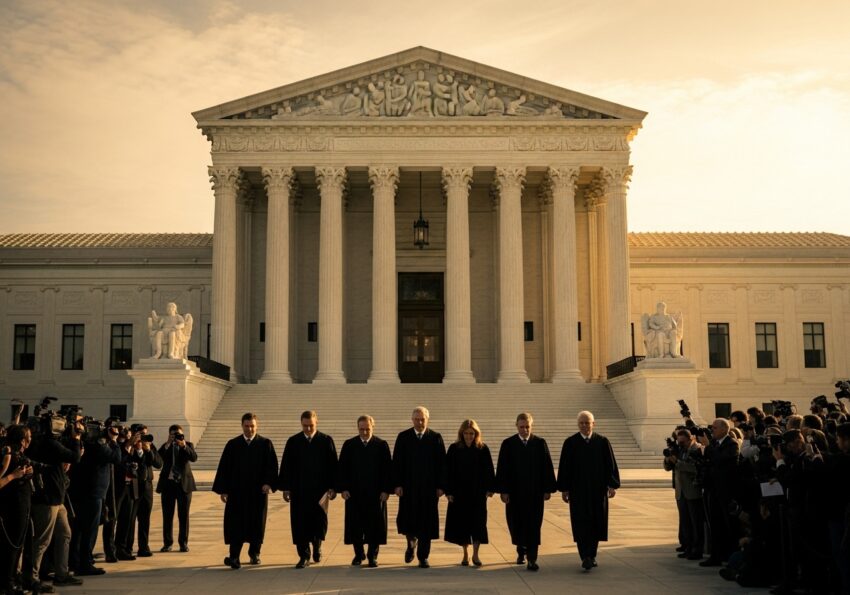For decades, left-wing activists have weaponized the courts to undermine conservative policies they couldn’t defeat at the ballot box. Nationwide injunctions—often issued by activist judges in carefully-chosen jurisdictions—became their favorite tool to stall the MAGA agenda, from border security and immigration reform to restoring American manufacturing and energy independence. But last Friday, the Supreme Court finally brought down the judicial hammer on these abuses, delivering a decisive win for President Trump and the America First movement.
In a landmark 6-3 ruling, the Court declared that district courts have no authority to issue universal injunctions. The case, Trump v. Casa, addressed the controversial issue of birthright citizenship, but the justices wisely avoided wading into that policy quagmire. Instead, they struck at the heart of judicial overreach, dismantling a strategy the Left had abused to thwart conservative governance time and again.
Justice Amy Coney Barrett, writing for the conservative majority, firmly grounded her opinion in originalist principles. She made clear that nationwide injunctions—orders from a single federal judge that halt policies across the entire nation—are a modern invention with no historical basis. Barrett stated unequivocally, “Universal injunctions likely exceed the equitable authority that Congress has given to federal courts.”
Barrett’s opinion took a methodical, historical approach, emphasizing that the Judiciary Act of 1789, which empowers federal courts to issue injunctions, never contemplated such sweeping judicial decrees. Citing the lack of precedent in English common law at the founding, Barrett wrote: “Neither the universal injunction nor any analogous form of relief was available in the High Court of Chancery in England at the time of the founding. Equity offered a mechanism for the Crown ‘to secure justice where it would not be secured by the ordinary and existing processes of law.’ Nor did founding-era courts of equity in the United States chart a different course. The bottom line? The universal injunction was conspicuously nonexistent for most of our Nation’s history.”
The Judiciary Act of 1789 endowed federal courts with jurisdiction over “all suits . . . in equity,” §11, 1 Stat. 78, and still today, this statute “is what authorizes the federal courts to issue equitable remedies,” S. Bray & E. Sherwin, Remedies 442 (4th ed. 2024). Though flexible, this equitable authority is not freewheeling. We have held that the statutory grant encompasses only those sorts of equitable remedies “traditionally accorded by courts of equity” at our country’s inception. … We must therefore ask whether universal injunctions are sufficiently “analogous” to the relief issued “‘by the High Court of Chancery in England at the time of the adoption of the Constitution and the enactment of the original Judiciary Act.’” Grupo Mexicano, 527 U. S., at 318–319 (quoting A. Dobie, Handbook of Federal Jurisdiction and Procedure 660 (1928)).
The answer is no: Neither the universal injunction nor any analogous form of relief was available in the High Court of Chancery in England at the time of the founding. Equity offered a mechanism for the Crown “to secure justice where it would not be secured by the ordinary and existing processes of law.”
Nor did founding-era courts of equity in the United States chart a different course.
The bottom line? The universal injunction was conspicuously nonexistent for most of our Nation’s history. Its absence from 18th- and 19th-century equity practice settles the question of judicial authority.
Not surprisingly, the Court’s liberal wing was outraged. Justice Ketanji Brown Jackson, the Court’s increasingly strident left-wing activist, accused the majority of allowing the executive branch to violate constitutional rights unchecked. “The Court’s decision to permit the Executive to violate the Constitution with respect to anyone who has not yet sued is an existential threat to the rule of law,” she wrote. Barrett, however, swiftly dismissed Jackson’s hyperbole, noting tartly that Jackson “decries an imperial Executive while embracing an imperial Judiciary.”
Stripping away the ability to impose nationwide injunctions is a significant blow to the leftist “lawfare” strategy. For years, groups like the ACLU and others have venue-shopped for sympathetic judges in liberal strongholds to block national policies they opposed but couldn’t defeat democratically. Now, district courts will only be able to apply their judgments beyond their immediate regions if the plaintiffs file valid class-action suits demonstrating real, common injuries.
Carrie Severino, from the conservative Judicial Crisis Network, hit the nail on the head, declaring, “The Court has shut the door on the abuse of universal injunctions. Today’s decision is a victory for our constitutional separation of powers. Justice Alito’s concurrence sounds the alarm that litigants have been attempting to abuse class actions and standing processes as well and shows that the Court is well aware of the problem and prepared to police those boundaries to shut down judicial activists.”
This ruling doesn’t just correct a procedural anomaly; it restores balance to our constitutional order. It ensures that federal judges cannot single-handedly dictate national policy. Most importantly, it safeguards the America First agenda from sabotage by unelected judicial activists. The era of judicial supremacy is finally receding, making way for a government truly by and for the American people.
Click this link for the original source of this article.
Author: rachel
This content is courtesy of, and owned and copyrighted by, https://www.nationalinsiders.com and its author. This content is made available by use of the public RSS feed offered by the host site and is used for educational purposes only. If you are the author or represent the host site and would like this content removed now and in the future, please contact USSANews.com using the email address in the Contact page found in the website menu.








